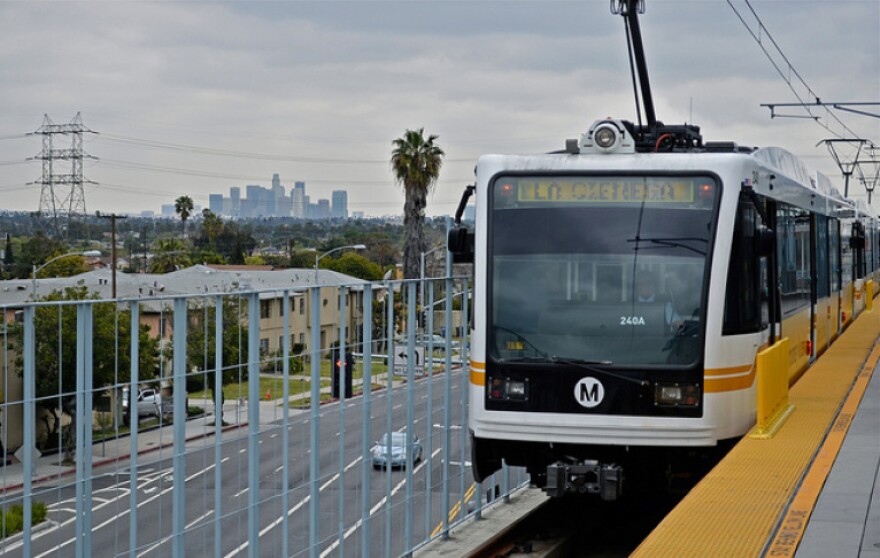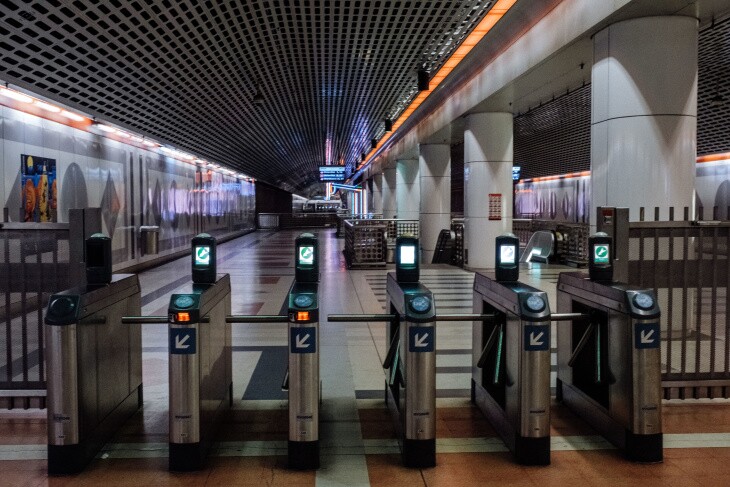With our free press under threat and federal funding for public media gone, your support matters more than ever. Help keep the LAist newsroom strong, become a monthly member or increase your support today.
Want To Save Money On Public Transit In LA County? Here’s How

Maybe you’ve heard by now that Los Angeles County’s transit agency has resumed fare collection on its buses (most of them anyway).
Public transit ridership suffered a severe pandemic plunge (and was already in decline before that), but it’s on the road to recovery — and L.A. Metro is in the midst of a historic expansion of service for both bus and rail lines. At the same time, the agency wants to encourage more people to use its system. One initiative: reducing fares and, for some riders, waiving them altogether.
When we reported earlier this week on the end of free bus trips, we got some good questions from readers. We answered those individually and realized we could help guide more Angelenos about the ins and outs of affording public transit in L.A.
Below you will see several options for riders based on income, age or educational status. We’re here to help you understand which fare discounts are available to you and how to apply so you can start riding.
Discounts For Low-Income Riders
Although Metro estimates roughly 70% of its riders qualify as low-income, the agency has struggled to enroll them in its reduced fare program, dubbed Low-Income Fare is Easy, or LIFE.
Early last year, then-Metro CEO Phillip Washington told his board that program enrollment "has not been very successful" and said the agency would work to redesign the process.
That work was steered by Sholanda Baldwin, Metro’s executive officer of administration, who said her team worked to “open up the program and alleviate some of the barriers” for riders to sign up.
In late September 2021, enrollment was just over 91,000. After launching a streamlined application process in October, Metro ended the year with 100,000 riders enrolled.
“Our goal is to double that enrollment by the end of 2022, so full steam ahead,” she said.
Metro is offering even deeper discounts on its low-income passes right now — and free rides for new enrollees (for a limited time).
Through late July, qualifying riders will pay:
- $26 for a 30-day pass (usually $76)
- $6.50 for a 7-day pass (usually $19.50)
Metro also announced that new LIFE program enrollees will ride for free for the first 90 days after bus fare collection resumed, which happened Jan. 10. That means free rides for new LIFE enrollees until early April.
Discounted rides aren't only for L.A. Metro trains and buses. Several other transit agencies also participate in the program, including:
- Santa Clarita Transit
- LADOT Dash
- Long Beach Transit
- Montebello Bus
- Norwalk Transit
- Santa Monica Big Blue Bus
The full list is available on Metro's LIFE webpage.
LIFE program participants can also use Metro's bike share at a discount: $5 for a 30-day pass and $50 for the whole year.
Where To Apply For The LIFE Program
One key improvement to the program: a streamlined online application form, which is also available in Spanish.
Applications can also be submitted in person at Metro’s customer centers (locations at this link), the Big Blue Bus transit store, or through these two community organizations that have partnered with Metro to boost enrollment:
FAME
(323) 870-8567 | lifeinfo@famecorporations.org
1968 W. Adams Blvd.
Los Angeles, CA 90018
International Institute of Los Angeles (IILA)
818-244-2550 | lifeinfo@iilosangeles.org
3800 La Crescenta Avenue, Suite 209
Glendale, CA 91214
The paper application forms also have been simplified and can be downloaded from Metro’s website in both English and Spanish.
IILA has also published informational brochures about the LIFE program in Korean, Armenian, Chinese and Khmer.
Who Is Eligible To Apply?
Riders who qualify, based on Metro’s income brackets:
- Households of one with annual income of $41,400 or less
- Households of two with annual income of $47,300 or less
- Households of three with annual income of $53,200 or less
- Households of four with annual income of $59,100 or less
- Households of five with annual income of $63,850 or less
- Households of six with annual income of $68,600 or less

So how do you prove your status as low-income? Right now, eligibility for the program is on the honor system. There’s a box applicants can check to self-certify their income level if they don’t wish to or cannot provide documents to verify it.
Metro may develop a verification process “down the road,” according to Baldwin, but for now, the benefits of reducing the financial burden to low-income residents — who make up the majority of transit riders — vastly outweigh any potential fraud.
“We don't envision implementing that at least for the first year of the program,” she said. “We'll certainly make sure when we do establish that program, that it’s a fair, equitable process — and that it also does not create any adverse impacts to individuals that are, rightfully so, enrolled in the program.”
Riders that do have proof of income and want to provide it can still submit a document. According to the application form, acceptable forms include:
- EBT card
- Medi-Cal card
- Social Security Award
- Social Security Disability Award
- General relief cash aid eligibility letter
- Unemployment letter
- SNAP eligibility letter
- TANF eligibility letter
- CalFresh eligibility letter
- Free or reduced lunch letter
- Check stub or tax return form
- Wages and tax statement form (form 1099 or W-2)
- Bank statement indicating direct deposits from the U.S. Treasury
- Bank statements indicating employer direct deposit
What Else Do I Need To Apply?
The basics you’ll have to provide are:
- Some form of photo ID
- Your address
- Your contact information (email or phone number)
So how long will you have to wait between applying and getting your TAP card? Baldwin says it takes about 72 hours for Metro to contact riders and let them know they’re approved. After that, a TAP card are mailed out to the address provided.
There was a faster way, through Metro’s pop-up enrollment events, which offered enrollment and TAP cards “on the spot,” Baldwin said. But Metro canceled those in-person events this month, citing health concerns due to the record surge in COVID cases.
Free Fare For (Many) K-12 Students
This past October, Metro launched the first phase of its fareless transit pilot program by offering hundreds of thousands of local K-12 students free transit.
Right now that includes L.A. Unified and more than a dozen other school districts.
The agency created a cost-sharing agreement where local school districts opt-in and pay $3 per student per year so all of its students can access transit for free. The free rides are currently set to run through June 2023.
Here’s what you need to do:
First, students from participating school districts must get a GoPass TAP card from their school. Metro keeps a list of participating schools and includes a phone number (though we’re not sure how often it’s updated).
To start riding free, students have to activate their TAP cards by visiting the GoPass Program website or by calling 866-TAP-TOGO (866-827-8646).
Free transit trips extend beyond Metro’s own buses and trains. Several municipal transit agencies are also taking part in the program:
- City of Commerce
- Culver CityBus
- LADOT Dash
- Long Beach Transit
- Montebello Bus
- Norwalk Transit
- Santa Monica Big Blue Bus
Free And Reduced Fares For College Students

The Los Angeles Community College District also recently entered a cost-sharing agreement with Metro, granting its roughly 200,000 students access to free transit.
To get their free transit passes, college students can either pick up a GoPass TAP card on campus or get a digital version on their smartphone with a code provided by their school.
Free transit is available to all LACCD students at all nine campuses:
- Los Angeles City College
- Harbor College
- Pierce College
- Valley College
- Mission College
- L.A. Trade-Tech College
- East L.A. College
- Southwest College
- West L.A. College
LACCD’s agreement with Metro is currently set to expire at the end of 2022, but agency officials say it may be extended to the full duration of the pilot — which ends June 2023.
“We will circle back with [LACCD] regarding the pricing for the remaining six months once we have more information based on their actual participation,” spokesman Dave Sotero told LAist last month.
For all other local college and vocational students, Metro offers discounted transit passes through its U-Pass program.
The reduced fare prices vary, but are also good for trips on Metro’s partner agencies in cities including L.A., Long Beach, Santa Monica, Culver City, Norwalk, Pasadena and Montebello.
You can check to see if your campus participates in the program at this link.
Senior Discounts Remain In Place
Transit riders ages 62 and over qualify for Metro’s senior discounts. Those rates are:
- 1-Way fare: 75 cents / 35 cents for off-peak (weekdays 9 a.m. - 3 p.m. and 7 p.m. - 5 a.m.; weekends and federal holidays)
- 1-day pass: $2.50
- 30-day pass: $20
- LIFE 30-day pass: $12
Seniors who want to get their TAP cards can apply in-person at one of Metro’s customer centers (locations at this link). Applications can also be submitted online.
Applicants must provide “a current 2” × 2” or 1” × 1¼ full face photo” and an official photo ID, Metro states on its website (more details are available at this link).

For All Other Riders
Anyone who does not qualify under Metro’s low-income, senior or student fare programs can still save some money on fares — for about half of the year.
One-way fares are still $1.75, but the agency has reduced its pass prices by half until July 20, 2022. That means right now it costs:
- $3.50 for a day pass
- $12.50 for a weekly pass
- $50 for a 30-day pass
To buy or reload your TAP card, you can visit taptogo.net, call 866-TAP-TOGO (866-827-8646), visit a TAP vendor location (there are over 450 of them), or get one from the TAP vending machines located at all Metro stations.
What Was All That Talk About A Free Transit System?

When then-CEO Philip Washington launched the Fareless System Initiative in September 2020, he said Metro had a “moral obligation” to create a 100% free transit system as “a public right and common good.”
Community advocates agree, like Scarlett De Leon, campaign director for L.A.’s Alliance for Community Transit.
“For us, the number one thing is to make sure we get to a universal fareless system where folks don't have to prove their income and everyone has access… regardless of income levels,” she said. “It's important to get all of Los Angeles riding public transportation, just in general, for the health of our city.”
Free fares for K-12 and community college students is the first phase of Metro’s pilot program to study how that might look.
Metro officials say they might expand the pilot to include low-income riders “at a future date,” but that future is in question. The agency is working to secure long-term state and federal funding to keep the pilot going. It’s currently set to expire in June 2023.
While rider fares typically (as in pre-pandemic) bring Metro millions of dollars each year, it represents a tiny slice of the agency's annual revenue. In its 2020 budget — approved pre-COVID — fare revenues made up just 4% of Metro's projected resources for that fiscal year.
The agency has estimated that roughly one third of the operating costs generated by fares go toward expenses related to fare collection, such as enforcement, accounting and fare box maintenance.
If you want to voice your support or concerns about fareless transit, you can email L.A. Metro staff at fareless@metro.net.







